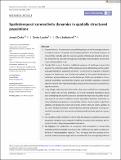Files in this item
Spatiotemporal connectivity dynamics in spatially structured populations
Item metadata
| dc.contributor.author | Drake, Joseph | |
| dc.contributor.author | Lambin, Xavier | |
| dc.contributor.author | Sutherland, Chris | |
| dc.date.accessioned | 2022-08-01T09:30:03Z | |
| dc.date.available | 2022-08-01T09:30:03Z | |
| dc.date.issued | 2022-10 | |
| dc.identifier | 280616379 | |
| dc.identifier | 952f973f-d23c-4611-b4a9-4fcdaf4c985c | |
| dc.identifier | 85135156615 | |
| dc.identifier | 000832924200001 | |
| dc.identifier.citation | Drake , J , Lambin , X & Sutherland , C 2022 , ' Spatiotemporal connectivity dynamics in spatially structured populations ' , Journal of Animal Ecology , vol. 91 , no. 10 , pp. 2050-2060 . https://doi.org/10.1111/1365-2656.13783 | en |
| dc.identifier.issn | 0021-8790 | |
| dc.identifier.other | RIS: urn:0F16E68565D814C02F6107171C922811 | |
| dc.identifier.other | ORCID: /0000-0003-2073-1751/work/116910455 | |
| dc.identifier.uri | https://hdl.handle.net/10023/25757 | |
| dc.description | This work was supported in part by the UMass Organismal and Evolutionary Biology Graduate Research Grant and UMass Graduate School Fieldwork Grant. | en |
| dc.description.abstract | 1. Connectivity is a fundamental concept linking dispersal to the emergent dynamics and persistence of spatially structured populations. Functional measures of connectivity typically seek to integrate aspects of landscape structure and animal movement to describe ecologically meaningful connectedness at the landscape and population scale. 2. Despite this focus on function, traditional measures of landscape connectivity assume it is a static property of the landscape, hence abstracting out the underlying spatiotemporal population dynamics. Connectivity is, arguably, a dynamic property of landscapes, and is inherently related to the spatial distribution of individuals and populations across the landscape. Static representations of connectivity potentially overlook this variation and therefore adopting a dynamic approach should offer improved insights about connectivity and associated ecological processes. 3. Using a large scale, long-term time-series of occupancy data from a metapopulation of water voles (Arvicola amphibius), we tested competing hypotheses about how considering the dynamic nature of connectivity improves the ability of spatially-explicit occupancy models to recover population dynamics. Iteratively relaxing standing assumptions of connectivity metrics, these models ranged from spatially and temporally fixed connectivity metrics that are widely applied, to the more flexible, but lesser used model that allowed temporally-varying connectivity measures that incorporate spatiotemporally dynamic patch occupancy states. 4. Our results provide empirical evidence that demographic-weighting using patch occupancy dynamics and temporal variability in connectivity measures are important for describing metapopulation dynamics. 5. We highlight the implications of commonly held assumption in connectivity modelling and demonstrate how they result in different and highly variable predictions of metapopulation capacity. Thus, we argue that the concept of connectivity and its potential applications would benefit from recognizing inherent spatiotemporal variation in connectivity that is explicitly linked to underlying ecological state variables. | |
| dc.format.extent | 11 | |
| dc.format.extent | 1202668 | |
| dc.language.iso | eng | |
| dc.relation.ispartof | Journal of Animal Ecology | en |
| dc.subject | Stochastic patch occupancy model | en |
| dc.subject | Mammal | en |
| dc.subject | Structural connectivity | en |
| dc.subject | Population dynamics | en |
| dc.subject | Bayesian | en |
| dc.subject | SPOM | en |
| dc.subject | Spatially realistic metapopulation model | en |
| dc.subject | Colonization-extinction | en |
| dc.subject | GE Environmental Sciences | en |
| dc.subject | QA Mathematics | en |
| dc.subject | QH301 Biology | en |
| dc.subject | DAS | en |
| dc.subject.lcc | GE | en |
| dc.subject.lcc | QA | en |
| dc.subject.lcc | QH301 | en |
| dc.title | Spatiotemporal connectivity dynamics in spatially structured populations | en |
| dc.type | Journal article | en |
| dc.contributor.institution | University of St Andrews. Statistics | en |
| dc.contributor.institution | University of St Andrews. Centre for Research into Ecological & Environmental Modelling | en |
| dc.identifier.doi | 10.1111/1365-2656.13783 | |
| dc.description.status | Peer reviewed | en |
This item appears in the following Collection(s)
Items in the St Andrews Research Repository are protected by copyright, with all rights reserved, unless otherwise indicated.

